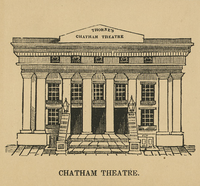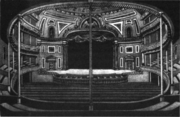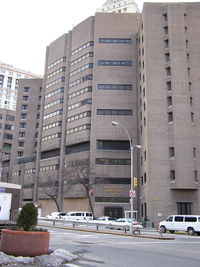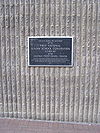
Chatham Garden Theatre
Encyclopedia

- For the other theatre of this name, see Chatham TheatreChatham TheatreThe Chatham Theatre or Chatham Street Theatre was a playhouse on the east side of Chatham Street in New York City. It was located between Roosevelt and James streets, a few blocks south of the Bowery. At its opening in 1839, the Chatham was a neighborhood establishment, which featured big-name...
.
The Chatham Garden Theatre or Chatham Theatre was a playhouse
Playhouse
Playhouse is a common Elizabethan term for a theatre, especially those built in London such as The Globe and The Rose.It is also used as the name for theatres today:- Australia :* Dunstan Playhouse, Adelaide Festival Centre...
in the Chatham Gardens of New York City
New York City
New York is the most populous city in the United States and the center of the New York Metropolitan Area, one of the most populous metropolitan areas in the world. New York exerts a significant impact upon global commerce, finance, media, art, fashion, research, technology, education, and...
. It was located on the north side of Chatham Street on Park Row between Pearl and Duane streets in lower Manhattan
Manhattan
Manhattan is the oldest and the most densely populated of the five boroughs of New York City. Located primarily on the island of Manhattan at the mouth of the Hudson River, the boundaries of the borough are identical to those of New York County, an original county of the state of New York...
. The grounds ran through to Augustus Street. The Chatham Garden Theatre was the first major competition to the high-class Park Theatre, though in its later years it sank to the bottom of New York's stratified theatrical order, below even the Bowery Theatre
Bowery Theatre
The Bowery Theatre was a playhouse in the Bowery neighborhood of New York City. Although it was founded by rich families to compete with the upscale Park Theatre, the Bowery saw its most successful period under the populist, pro-American management of Thomas Hamblin in the 1830s and 1840s...
.
The Chatham Garden was converted to the Free Presbyterian Chatham Street Chapel in 1832.
Creation and early seasons
The theatre began quite humbly. In 1823 Hippolite Barrière, the manager of the Chatham Gardens in New York CityNew York City
New York is the most populous city in the United States and the center of the New York Metropolitan Area, one of the most populous metropolitan areas in the world. New York exerts a significant impact upon global commerce, finance, media, art, fashion, research, technology, education, and...
, erected a white, canvas tent in his public pleasure grounds. He dubbed it the Pavilion Theatre and began staging drama there with a ticket price of 25¢. The tent, which was used for other concerts and plays, also housed a saloon
Bar (establishment)
A bar is a business establishment that serves alcoholic drinks — beer, wine, liquor, and cocktails — for consumption on the premises.Bars provide stools or chairs that are placed at tables or counters for their patrons. Some bars have entertainment on a stage, such as a live band, comedians, go-go...
. The makeshift playhouse operated through the summer, perhaps the first such summer theatre in the United States.
Stephen Price, manager of New York's Park Theatre
Park Theatre (Manhattan)
The Park Theatre, originally known as the New Theatre, was a playhouse in New York City, located at 21, 23, and 25 Park Row, about east of Ann Street and backing Theatre Alley. The location, at the north end of the city, overlooked the park that would soon house City Hall...
, tried to put a stop to Barrière's enterprise by reporting the tent to the authorities as a fire hazard. Barrière responded by erecting a brick-and-mortar structure on the site. The new building, named the Chatham Garden Theatre, opened on 17 May 1824 and played through the normal season.

Auditorium
An auditorium is a room built to enable an audience to hear and watch performances at venues such as theatres. For movie theaters, the number of auditoriums is expressed as the number of screens.- Etymology :...
, and it did not admit African American
African American
African Americans are citizens or residents of the United States who have at least partial ancestry from any of the native populations of Sub-Saharan Africa and are the direct descendants of enslaved Africans within the boundaries of the present United States...
s. The balcony was on the same level as the lobby and fronted the garden. The walls had slits and the doorways only blinds to facilitate airflow. Karl Bernhard, a visitor to New York in 1825-26, left this description:
However, the theatre's location was difficult to find. It was only accessible by passing through private buildings on the west side of Chatham Street. The New York Mirror
New York Mirror
The New-York Mirror was a weekly newspaper published in New York City from 1823 to 1842, and again as a daily newspaper renamed The Evening Mirror from 1844 to 1898.-History:...
resorted to printing a map to show how to reach the place and offered these instructions:
The Chatham Garden Theatre offered popular actors at reasonable prices, and it did well. The playhouse provided the first real competition for the upper-class Park Theatre in its second season, which began on 9 May 1825. It remained a classy establishment for the next three seasons. During this time, it produced the first two American operas, The Sawmill
The Sawmill
The Sawmill is a 1922 film directed by Larry Semon and featuring Oliver Hardy.-Cast:* Larry Semon - The dumb-bell* Oliver Hardy - The foreman * Frank Alexander - Mill owner* Kathleen O'Connor - The boss's daughter...
in 1824 and The Forest Rose in 1825.
Later management
Barrière died on 21 February 1826. On 15 March, the Chatham Garden Theatre was sold at auction to Henry Wallack for $4,500. Wallack reopened it on 20 March for a four-month season. He then refurbished and redecorated the playhouse before reopening on 9 October 1826. However, Wallack went bankruptBankruptcy
Bankruptcy is a legal status of an insolvent person or an organisation, that is, one that cannot repay the debts owed to creditors. In most jurisdictions bankruptcy is imposed by a court order, often initiated by the debtor....
, and he was forced to close the Chatham Garden Theatre in April 1827.
Later managers changed the theatre's focus from upper-class drama and opera
Opera
Opera is an art form in which singers and musicians perform a dramatic work combining text and musical score, usually in a theatrical setting. Opera incorporates many of the elements of spoken theatre, such as acting, scenery, and costumes and sometimes includes dance...
to fare that appealed to the lower classes. A man named Megary took over as lessee and managed a short season beginning 16 June 1827 and another beginning on 3 December. Kilner and Maywood followed him, with a season beginning 9 June 1828.
In 1829, James H. Hackett took over and renamed the building the American Opera House. He offered two seasons of primarily light, popular music from 20 May 1829 to 1 September 1829. George Barrett and C. Young took over from him on 24 December, but their tenure lasted less than two weeks. The Opera House became Blanchard's Amphi-theatre on 18 January 1830, which specialized in equestrian entertainment
Equestrianism
Equestrianism more often known as riding, horseback riding or horse riding refers to the skill of riding, driving, or vaulting with horses...
and light drama. S. Phillips followed as manager on 11 March 1831; he lasted until May when Charles R. Thorne took the role. Finally, Thomas S. Hamblin
Thomas S. Hamblin
Thomas Sowerby Hamblin was an English actor and theatre manager. He first took the stage in England, then immigrated to the United States in 1825. He received critical acclaim there, and eventually entered theatre management. During his tenure at New York City's Bowery Theatre he helped establish...
purchased the theatre in late June 1831. The 1831-2 season was its last.
Since Barrière's death, the Chatham Garden had slipped to the low end of New York's entertainment industry. It was known for fistfights among its patrons, drunken brawls, and openness to prostitution. Of New York's three big theatres (the Park and the Bowery
Bowery Theatre
The Bowery Theatre was a playhouse in the Bowery neighborhood of New York City. Although it was founded by rich families to compete with the upscale Park Theatre, the Bowery saw its most successful period under the populist, pro-American management of Thomas Hamblin in the 1830s and 1840s...
being the other two), it had the roughest reputation. Brothel
Brothel
Brothels are business establishments where patrons can engage in sexual activities with prostitutes. Brothels are known under a variety of names, including bordello, cathouse, knocking shop, whorehouse, strumpet house, sporting house, house of ill repute, house of prostitution, and bawdy house...
s thrived on the same block. Frances Trollope
Frances Trollope
Frances Milton Trollope was an English novelist and writer who published as Mrs. Trollope or Mrs. Frances Trollope...
described the playhouse in no uncertain terms:
Nevertheless, Mrs Trollope's description reveals that the theatre may not have been as raffish as its reputation made it sound. The presence of a nursing mother suggests that the theatre was lower-class, certainly, but also family-oriented.
Presbyterian chapel

Lewis Tappan
Lewis Tappan was a New York abolitionist who worked to achieve the freedom of the illegally enslaved Africans of the Amistad. Contacted by Connecticut abolitionists soon after the Amistad arrived in port, Tappan focused extensively on the captive Africans...
and William Green
William Green
William Green may refer to:*S. William Green , former U.S. congressman from New York*William Ellis Green , Australian cartoonist*William Green , American football player...
rented the building. They offered it to the Presbyterian minister Charles Grandison Finney
Charles Grandison Finney
Charles Grandison Finney was a leader in the Second Great Awakening. He has been called The Father of Modern Revivalism. Finney was best known as an innovative revivalist, an opponent of Old School Presbyterian theology, an advocate of Christian perfectionism, a pioneer in social reforms in favor...
, a radical Abolitionist who converted it into the Free Presbyterian Chatham Street Chapel. In October 1832, the chapel was the site of the first national Sunday School
Sunday school
Sunday school is the generic name for many different types of religious education pursued on Sundays by various denominations.-England:The first Sunday school may have been opened in 1751 in St. Mary's Church, Nottingham. Another early start was made by Hannah Ball, a native of High Wycombe in...
convention in the United states. Over the next ten years, at first here, then from 1835-36 at the massive new Broadway Tabernacle
Broadway United Church of Christ
Broadway United Church of Christ is a Congregationalist Church at Broadway and 93rd Street on the Upper West Side of Manhattan.- Finney's Broadway Tabernacle :...
, Finney gave sermons each Sunday to crowds as large as 3000 and led revival
Revival meeting
A revival meeting is a series of Christian religious services held in order to inspire active members of a church body, to raise funds and to gain new converts...
s three times a week. The Sacred Music Society, a popular religious choir
Choir
A choir, chorale or chorus is a musical ensemble of singers. Choral music, in turn, is the music written specifically for such an ensemble to perform.A body of singers who perform together as a group is called a choir or chorus...
, rented the building for two nights a week in this period at a cost of $850 a year. Philip Hone
Philip Hone
Philip Hone was Mayor of New York from 1826 to 1827. He was most notable for a detailed diary he kept from 1828 until the time of his death in 1851. His recorded diary is said to be the most extensive and detailed of his time in 19th century America.Son of a German immigrant carpenter, Hone became...
described his reaction to a performance in 1835:

Metropolitan Correctional Center
Metropolitan Correctional Center is the name of several federal prisons in the United States:*Metropolitan Correctional Center, Chicago*Metropolitan Correctional Center, New York City*Metropolitan Correctional Center, San Diego...
federal facility housing male and female pre-trial and holdover inmates, serving the Southern District of New York
United States District Court for the Southern District of New York
The United States District Court for the Southern District of New York is a federal district court. Appeals from the Southern District of New York are taken to the United States Court of Appeals for the Second Circuit The United States District Court for the Southern District of New York (in case...
.

